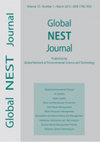NATURAL ORGANIC MATTER FRACTIONATION ALONG THE TREATMENT OF WATER FOR HUMAN CONSUMPTION
IF 1.2
4区 环境科学与生态学
Q4 ENVIRONMENTAL SCIENCES
引用次数: 14
Abstract
The main objective of this study was to characterize the organic matter present in raw water and along the treatment process, as well as itsseasonal variation.A natural organic matter fractionation approach has been applied to Lever water treatment plant located in Douro River, in Oporto (Portugal). The process used was based on the sorption of dissolved organic matter in different types of ion exchange resins, DAX-8, DAX-4 and IRA-958, allowing its separation into four fractions: very hydrophobic acids (VHA), slightly hydrophobic acids (SHA), charged hydrophilic (CHA) and hydrophilic neutral (NEU). The dissolved organic carbon (DOC) determi nation was used to quantify dissolved organic matter. Samples werecollected monthly, during approximately one year, from raw water captured at the surface and under the bed of the river, and after each step of the treatment: pre-filtration in sand/anthrac ite filters, ozonation, coagulation/flocculation, counter current dissolved air flotation and filtration (CoCoDAFF) and chlorination. The NEU fraction showed a seasonal variation, with maximum values in autumn for the sampling points corresponding toraw water captured at the surface and under the bed of the river . It was usually the predominating fraction and did not show a significant decreasethroughout the treatment. Nevertheless their low concentration, the same occurred for the CHA and VHA fractions.There was an overalldecrease in the SHA fraction throughout the water treatment (especiallyafterCoCoDAFF and ozonation)as well as in theDOC . The TSUVA 254 values obtainedfor raw watergenerally variedbetween 2.0 and 4.0LmgC -1 m -1 and between 0.75and 1.78 LmgC -1 m -1 for treated water. It wa s observed a decrease of TSUVA values along the treatment,especially after ozonation. These results may contribute to a further optimization in the process of treating water for human consumption.天然有机物沿处理水供人类饮用
本研究的主要目的是表征原水和处理过程中存在的有机物,以及其季节性变化。天然有机物分馏方法已应用于位于波尔图(葡萄牙)杜罗河的Lever水处理厂。所使用的工艺是基于不同类型的离子交换树脂(DAX-8, DAX-4和IRA-958)对溶解有机物的吸附,将其分离成四个部分:非常疏水酸(VHA),轻微疏水酸(SHA),带电亲水性(CHA)和亲水性中性(NEU)。采用溶解有机碳(DOC)测定法定量测定溶解有机质。在大约一年的时间里,从河面和河床下捕获的原水中每月收集样品,并在处理的每个步骤:砂/无烟煤过滤器预过滤、臭氧化、混凝/絮凝、逆流溶气浮选和过滤(CoCoDAFF)和氯化后收集样品。NEU分数呈季节性变化,在地表和河床下捕获的淡水对应的采样点在秋季达到最大值。它通常是主要的部分,在整个治疗过程中没有显示出明显的下降。尽管它们的浓度很低,但CHA和VHA部分也出现了同样的情况。在整个水处理过程中(特别是在cocodaff和臭氧化之后),以及在doc中,SHA分数总体下降。原水的TSUVA - 254值通常在2.0 - 4.0LmgC -1 m -1之间变化,处理水的TSUVA - 254值在0.75 - 1.78 LmgC -1 m -1之间变化。观察到沿处理方向的TSUVA值下降,特别是臭氧化后。这些结果可能有助于进一步优化人类饮用水的处理过程。
本文章由计算机程序翻译,如有差异,请以英文原文为准。
求助全文
约1分钟内获得全文
求助全文
来源期刊

Global Nest Journal
环境科学-环境科学
CiteScore
1.50
自引率
9.10%
发文量
100
审稿时长
>12 weeks
期刊介绍:
Global Network of Environmental Science and Technology Journal (Global NEST Journal) is a scientific source of information for professionals in a wide range of environmental disciplines. The Journal is published both in print and online.
Global NEST Journal constitutes an international effort of scientists, technologists, engineers and other interested groups involved in all scientific and technological aspects of the environment, as well, as in application techniques aiming at the development of sustainable solutions. Its main target is to support and assist the dissemination of information regarding the most contemporary methods for improving quality of life through the development and application of technologies and policies friendly to the environment
 求助内容:
求助内容: 应助结果提醒方式:
应助结果提醒方式:


